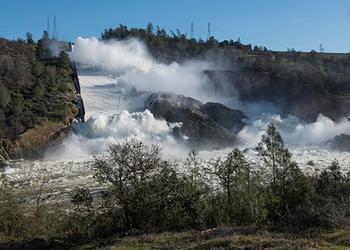
SACRAMENTO, California, February 13, 2017 (ENS) – More than 180,000 people near Lake Oroville in Butte County, California were evacuated from their homes Sunday as officials warned the auxiliary emergency spillway at Lake Oroville Dam could fail. Failure of the emergency spillway at America’s tallest dam could cause widespread and severe flooding along the Feather River Basin.
California Governor Jerry Brown issued an emergency order Sunday night mobilizing the California National Guard to bolster the state’s response to the situation at the Oroville Dam’s auxiliary spillway and support local evacuations.

“I’ve been in close contact with emergency personnel managing the situation in Oroville throughout the weekend and it’s clear the circumstances are complex and rapidly changing,” said Governor Brown.
In his emergency order, the governor explained that during January and February, three atmospheric river storm systems struck California, bringing massive amounts of rainfall.
This rainfall inundated lakes, rivers, and streams throughout the state, causing them to reach capacity, resulting in widespread flooding.
Lake Oroville in Butte County, in the western foothills of the Sierra Nevada, reached capacity February 7, causing officials to utilize the main spillway at Lake Oroville Dam to reduce the lake’s water levels. But the main spillway began to erode, causing officials to begin utilizing the auxiliary emergency spillway on February 11.
It is this auxiliary emergency spillway that is in danger of failing. Officials worry that failure could send a 30-foot wall of water into downtown Oroville and other communities along the Feather River.
“…the circumstances of this potential flooding by reason of its magnitude, are or are likely to be beyond the control of the services, personnel, equipment, and facilities of any single local government and require the combined forces of a mutual aid region or regions to combat,” Governor Brown said in his order.
“I find that conditions of extreme peril to the safety of persons and property exist in Butte, Sutter, and Yuba Counties due to this potential flooding…” wrote Brown.
“I want to thank local and state law enforcement for leading evacuation efforts and doing their part to keep residents safe. The state is directing all necessary personnel and resources to deal with this very serious situation,” the governor said Sunday night.
The Butte County Sheriff’s Office offered some relief in a tweet late last night, saying, “Flows over the auxiliary spillway have ceased. 100,000 cfs continue down the main spillway.”
Still, the Governor’s Office of Emergency Services has activated the State Operations Center in Mather, California to its highest level and is coordinating with personnel at the Incident Command Post in Oroville and with other local, state and federal emergency response officials to address all emergency management, evacuation and mutual aid needs.

The California Department of Water Resources, DWR, and the incident command team managing Lake Oroville are concerned that erosion at the head of the auxiliary spillway threatens to undermine the concrete weir and allow large, uncontrolled releases of water from Lake Oroville that could exceed the capacity of downstream channels.
To avert more erosion at the top of the auxiliary spillway, DWR doubled the flow down its main spillway from 55,000 cubic feet per second to 100,000 cfs.
“The next several hours will be crucial in determining whether the concrete structure at the head of the auxiliary spillway remains intact and prevents larger, uncontrolled flows,” said DWR in a statement Sunday night.
Current flows are contained with downstream channels. Flow over the auxiliary spillway weir began Saturday morning and has slowed considerably. DWR officials expect that flow to stop entirely soon, which will reduce the erosion on the downstream side of the structure.
DWR focused Saturday on ways to get the Hyatt Power Plant at Oroville Dam back in operation, because 14,000 cubic feet per second, cfs, can be discharged from the plant when it is operating, which would help with reservoir management.
Power generation was halted when the water levels in the channel that leads
from the power plant became high enough to compromise operation. Water levels rose when debris from the eroded concrete spillway piled up in the channel below.
“The same erosion also threatens the towers that hold the power lines that take electricity from the power plant to the electrical grid; such a connection is needed for the power plant to operate,” DWR said.
DWR, Pacific Gas & Electric Company, and other partners are working to safeguard the hydroelectric facility and power lines.
Oroville Dam itself is sound and is a separate structure from the auxiliary spillway.
Copyright Environment News Service (ENS) 2017. All rights reserved.
© 2017, Environment News Service. All rights reserved. Content may be quoted only with proper attribution and a direct link to the original article. Full reproduction is prohibited.
